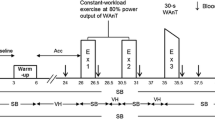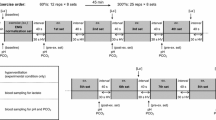Abstract
Isocapnic hyperpnoea has been shown to reliably produce fatigue of the diaphragm. The aim of the present study was to investigate whether incremental isocapnic hyperpnoea (IHincr) impairs the arm exercise performance and alters the breathing pattern during subsequent maximal incremental arm cranking. Nine healthy volunteers performed an arm cranking test with prior IHincr (ACIH) and without prior IHincr (ACcontrol). Minute ventilation (V ̇E), tidal volume (V T), breathing frequency (f b), O2 uptake (V̇O2), CO2 elimination (V̇CO2), respiratory exchange ratio (RER) and end-tidal partial pressure of CO2 (P ETCO2) were measured at three different time intervals (t 1: the average of the 3.30th min to the 6.30th min, t 2: 1 min before the end, t 3: peak value) and expressed as mean (SD). V T at t 1 and at t 3 was significantly (P<0.05) lower during ACIH [ACcontrol: t 1: 1.3 (0.5) l, t p: 1.9 (0.3) l; ACIH: t 1: 1.1 (0.3) l, t p: 1.6 (0.3) l]. f b at t 1 and t 2 was significantly (P<0.05) higher during ACIH [ACcontrol: t 1: 23 (4) breaths min−1, t 2: 42 (14) breaths min−1; ACIH: t 1: 27 (5) breaths min−1, t 2: 48 (14) breaths min−1]. The maximal voluntary ventilation (MVV), measured before and immediately after the IHincr, demonstrated a small but significant decrease from 157 (15) l min−1 to 150 (14) l min−1 (P<0.05) after the IHincr. In conclusion, rapid shallow breathing occurred during maximal arm cranking exercise after IHincr. The alteration was irrespective of the workload and had already occurred at the start of exercise.



Similar content being viewed by others
References
Bai TR, Rabinovitch BJ, Pardy RL (1984) Near-maximal voluntary hyperpnea and ventilatory muscle function. J Appl Physiol 57:1742–1748
Baydur A, Adkins RH, Milic-Emili J (2001) Lung mechanics in individuals with spinal cord injury: effects of injury level and posture. J Appl Physiol 90:405–411
Black LF, Hyatt RE (1969) Maximal respiratory pressures: normal values and relationship to age and sex. Am Rev Respir Dis 99:696–702
Celli B, Criner G, Rassulo J (1988) Ventilatory muscle recruitment during unsupported arm exercise in normal subjects. J Appl Physiol 64:1936–1941
Gallagher CG, Im Hof V, Younes M (1985) Effect of inspiratory muscle fatigue on breathing pattern. J Appl Physiol 59:1152–1158
Leith DE, Bradley M (1976) Ventilatory muscle strength and endurance training. J Appl Physiol 41:508–516
Linn WS, Adkins RH, Gong H, Waters RL (2000) Pulmonary function in chronic spinal cord injury: a cross-sectional survey of 222 southern California adult outpatients. Arch Phys Med Rehabil 81:757–763
Louhevaara V, Sovijarvi A, Ilmarinen J, Teraslinna P (1990) Differences in cardiorespiratory responses during and after arm crank and cycle exercise. Acta Physiol Scand 138:133–143
Mador MJ, Acevedo FA (1991a) Effect of respiratory muscle fatigue on breathing pattern during incremental exercise. Am Rev Respir Dis 143:462–468
Mador MJ, Acevedo FA (1991b) Effect of respiratory muscle fatigue on subsequent exercise performance. J Appl Physiol 70:2059–2065
Mador MJ, Rodis A, Diaz J (1996) Diaphragmatic fatigue following voluntary hyperpnea. Am J Respir Crit Care Med 154:63–67
Mador MJ, Sadaat K, Kufel TJ (2002) Bilateral anterolateral magnetic stimulation of the phrenic nerves can detect diaphragmatic fatigue. Chest 121:452–458
Magel JR, McArdle WD, Toner M, Delio DJ (1978) Metabolic and cardiovascular adjustments to arm training. J Appl Physiol 45:75–79
Martin B, Heintzelman M, Chen H (1982) Exercise performance after ventilatory work. J Appl Physiol 52:1581–1585
Quanjer PH, Tammeling GJ, Cotes JE, Pedersen OF, Peslin R, Yernault JC (1993) Lung volumes and forced ventilatory flows. Eur Respir J Suppl 16:5–40
Rochester DF, Arora NS (1983) Respiratory muscle failure. Med Clin N Am 67:573–597
Sawka MN, Foley ME, Pimental M, Toner M, Pandolf KB (1983) Determination of maximal aerobic power during upper-body exercise. J Appl Physiol 54:113–117
Schneider DA, Sedlock DA, Gass E, Gass G (1999) VO2peak and the gas-exchange anaerobic threshold during incremental arm cranking in able-bodied and paraplegic men. Eur J Appl Physiol 80:292–297
Sliwinski P, Sheng Y, Gauthier AP, Macklem PT (1996) Influence of global inspiratory muscle fatigue on breathing during exercise. J Appl Physiol 80:1270–1278
Spengler CM, Knöpfli-Lenzin C, Birchler K, Trapletti A, Boutellier U (2000) Breathing pattern and exercise endurance time after exhausting cycling or breathing. Eur J Appl Physiol 81:368–374
Washburn RA, Seals DR (1983) Comparison of continuous and discontinuous protocols for the determination of peak oxygen uptake in arm cranking. Eur J Appl Physiol 51:3–6
Washburn RA, Seals DR (1984) Peak oxygen uptake during arm cranking for men and women. J Appl Physiol 56:954–957
Weinberg J, Borg J, Bevegard S, Sinderby C (1999) Respiratory response to exercise in postpolio patients with severe muscle dysfunction. Arch Phys Med Rehabil 80:1095–1100
Acknowledgements
We acknowledge C.M. Spengler of the Swiss Federal Institute of Technology Zurich and University of Zurich (Switzerland) for kindly providing the device for isocapnic hyperpnoea. We thank the subjects for their time and voluntary but enthusiastic co-operation in this study.
Author information
Authors and Affiliations
Corresponding author
Rights and permissions
About this article
Cite this article
Van Houtte, S., Verellen, J., Gosselink, R. et al. Influence of isocapnic hyperpnoea on maximal arm cranking performance. Eur J Appl Physiol 90, 581–587 (2003). https://doi.org/10.1007/s00421-003-0910-7
Accepted:
Published:
Issue Date:
DOI: https://doi.org/10.1007/s00421-003-0910-7




